Game Analysis on Energy Enterprises’ Digital Transformation—Strategic Simulation for Guiding Role, Leading Role and Following Role
Abstract
1. Introduction
2. Literature Review
3. Game Model Building
3.1. Basic Assumptions
3.2. Model Logic
4. Evolutionary Game Analysis
4.1. Strategic Stability Analysis of Energy Enterprise 1
4.2. Strategic Stability Analysis of the Energy Enterprise 2
4.3. Strategic Stability Analysis of the Government
4.4. Stability Analysis of System Equilibrium Points
5. Numerical Simulation Analysis
5.1. Setting of Basic Parameters
5.2. The Effect of Different Initial Intentions on the Subject’s Game
5.3. Effect of Changes in Key Parameters on System Evolution
5.3.1. The Impact of Digital Transformation Costs and Benefits for Energy Companies on System Evolution Trends
5.3.2. Influence of the Cooperative Coefficient on System Evolutionary Trends
5.3.3. Impact of Government Subsidy and Penalty on System Evolutionary Trend
6. Findings and Discussion
6.1. Findings
6.2. Discussion
6.2.1. Theoretical Implications
6.2.2. Practical Implications
6.2.3. Limitations and Directions for Future Research
Author Contributions
Funding
Institutional Review Board Statement
Informed Consent Statement
Data Availability Statement
Conflicts of Interest
References
- Peng, S.; Jiang, X.; Li, Y. The impact of the digital economy on Chinese enterprise innovation based on intermediation models with financing constraints. Heliyon 2023, 9, e13961. [Google Scholar] [CrossRef] [PubMed]
- Ren, Y.; Zhang, X.; Chen, H. The Impact of New Energy Enterprises’ Digital Transformation on Their Total Factor Productivity: Empirical Evidence from China. Sustainability 2022, 14, 13928. [Google Scholar] [CrossRef]
- Gaglio, C.; Kraemer-Mbula, E.; Lorenz, E. The effects of digital transformation on innovation and productivity: Firm-level evidence of South African manufacturing micro and small enterprises. Technol. Forecast. Soc. Chang. 2022, 182, 121785. [Google Scholar] [CrossRef]
- Li, S.; Wang, Q. Green finance policy and digital transformation of heavily polluting firms: Evidence from China. Financ. Res. Lett. 2023, 55, 103876. [Google Scholar] [CrossRef]
- Guaita, J.M.; Puertas, R.; Martín, J.M.; Ribeiro-Soriano, D. Digitalization, innovation and environmental policies aimed at achieving sustainable production. Sustain. Prod. Consum. 2022, 32, 92–100. [Google Scholar] [CrossRef]
- Mutascu, M.; Horky, F.; Strango, C. Good or bad? Digitalisation and green preferences. Energy Econ. 2023, 121, 106640. [Google Scholar] [CrossRef]
- Matthess, M.; Kunkel, S.; Dachrodt, M.F.; Beier, G. The impact of digitalization on energy intensity in manufacturing sectors—A panel data analysis for Europe. J. Clean. Prod. 2023, 397, 136598. [Google Scholar] [CrossRef]
- Qi, P.; Sun, D.; Xu, C.; Li, Q.; Wang, Q. Can Data Elements Promote the High-Quality Development of China’s Economy? Sustainability 2023, 15, 7287. [Google Scholar] [CrossRef]
- Ha, L.T. Are digital business and digital public services a driver for better energy security? Evidence from a European sample. Environ. Sci. Pollut. Res. Int. 2022, 29, 27232–27256. [Google Scholar] [CrossRef]
- Wang, L.; Shao, J. Digital economy, entrepreneurship and energy efficiency. Energy 2023, 269, 126801. [Google Scholar] [CrossRef]
- Ren, S.; Hao, Y.; Xu, L.; Wu, H.; Ba, N. Digitalization and energy: How does internet development affect China’s energy consumption? Energy Econ. 2021, 98, 105220. [Google Scholar] [CrossRef]
- Wang, X.; Wang, X.; Ren, X.; Wen, F.H. Can digital financial inclusion affect CO2 emissions of China at the prefecture level? Evidence from a spatial econometric approach. Energy Econ. 2022, 109, 105966. [Google Scholar] [CrossRef]
- Verhoef, P.C.; Broekhuizen, T.; Bart, Y.; Bhattacharya, A.; Qi, D.J.; Fabian, N.; Haenlein, M. Digital transformation: A multidisciplinary reflection and research agenda. J. Bus. Res. 2021, 122, 889–901. [Google Scholar] [CrossRef]
- Sandberg, J.; Holmström, J.; Lyytinen, K. Digitization and Phase Transitions in Platform Organizing Logics: Evidence from the Process Automation Industry. Manag. Inf. Syst. Q. 2020, 44, 129–153. [Google Scholar] [CrossRef]
- Gurbaxani, V.; Dunkle, D. Gearing up for successful digital transformation. MIS Q. Exec. 2019, 18, 209–220. [Google Scholar] [CrossRef]
- Zhang, T.; Shi, Z.Z.; Shi, Y.R.; Chen, N.J. Enterprise digital transformation and production efficiency: Mechanism analysis and empirical research. Econ. Res.-Ekon. Istraz. 2022, 35, 2781–2792. [Google Scholar] [CrossRef]
- Na, C.; Chen, X.; Li, X.; Li, Y.; Wang, X. Digital Transformation of Value Chains and CSR Performance. Sustainability 2022, 14, 10245. [Google Scholar] [CrossRef]
- Guo, X.; Li, M.; Wang, Y.; Mardani, A. Does digital transformation improve the firm’s performance? From the perspective of digitalization paradox and managerial myopia. J. Bus. Res. 2023, 163, 113868. [Google Scholar] [CrossRef]
- Schiavone, F.; Sprenger, S. Operations management and digital technologies. Prod. Plan. Control. 2017, 28, 1281–1283. [Google Scholar] [CrossRef]
- Ghosh, S.; Hughes, M.; Hodgkinson, I.; Hughes, P. Digital transformation of industrial businesses: A dynamic capability approach. Technovation 2022, 113, 102414. [Google Scholar] [CrossRef]
- Gao, J.; Zhang, W.; Guan, T.; Mardani, A. The effect of manufacturing agent heterogeneity on enterprise innovation performance and competitive advantage in the era of digital transformation. J. Bus. Res. 2023, 155, 113387. [Google Scholar] [CrossRef]
- Huo, P.; Wang, L. Digital economy and business investment efficiency: Inhibiting or facilitating? Res. Int. Bus. Financ. 2022, 63, 101797. [Google Scholar] [CrossRef]
- Deng, H.; Bai, G.; Shen, Z.; Xia, X.Q. Digital economy and its spatial effect on green productivity gains in manufacturing: Evidence from China. J. Clean. Prod. 2022, 378, 134539. [Google Scholar] [CrossRef]
- Ren, X.; Zeng, G.; Gozgor, G. How does digital finance affect industrial structure upgrading? Evidence from Chinese prefecture-level cities. J. Environ. Manag. 2023, 330, 117125. [Google Scholar] [CrossRef]
- Cheng, Y.; Zhou, X.; Li, Y. The effect of digital transformation on real economy enterprises’ total factor productivity. Int. Rev. Econ. Financ. 2023, 85, 488–501. [Google Scholar] [CrossRef]
- Jin, C.; Xu, A.; Zhu, Y.; Li, J.C. Technology growth in the digital age: Evidence from China. Technol. Forecast. Soc. Change 2023, 187, 122221. [Google Scholar] [CrossRef]
- Li, S.; Tian, Y. How Does Digital Transformation Affect Total Factor Productivity: Firm-Level Evidence from China. Sustainability 2023, 15, 9575. [Google Scholar] [CrossRef]
- Radicic, D.; Petković, S. Impact of digitalization on technological innovations in small and medium-sized enterprises (SMEs). Technol. Forecast. Soc. Chang. 2023, 191, 122474. [Google Scholar] [CrossRef]
- Chen, X.; Zhou, P.; Hu, D. Influences of the ongoing digital transformation of the Chinese Economy on innovation of sustainable green technologies. Sci. Total Environ. 2023, 875, 162708. [Google Scholar] [CrossRef]
- Wang, J.; Wang, B.; Dong, K.; Dong, X. How does the digital economy improve high-quality energy development? The case of China. Technol. Forecast. Soc. Change 2022, 184, 121960. [Google Scholar] [CrossRef]
- Xu, Q.; Zhong, M.; Li, X. How does digitalization affect energy? International evidence. Energy Econ. 2022, 107, 105879. [Google Scholar] [CrossRef]
- Zhang, T.; Wei, L.; Liu, J. How China’s digital technology development affects the environmental costs related to global value chains? Evidence from regional manufacturing sectors. Sci. Total Environ. 2023, 886, 163978. [Google Scholar] [CrossRef]
- Galor, O.; Moav, O. From physical to human capital accumulation: Inequality and the process of development. Rev. Econ. Stud. 2004, 71, 1001–1026. [Google Scholar] [CrossRef]
- Galor, O. From stagnation to growth: Unified growth theory. In Handbook of Economic Growth; Aghion, P., Durlauf, S.N., Eds.; Elsevier: Amsterdam, The Netherlands, 2005; Volume I Part A, pp. 171–293. [Google Scholar]
- Azarnert, L.V. Transportation costs and the Great Divergence. Macroecon. Dyn. 2016, 20, 214–228. [Google Scholar] [CrossRef]
- Azarnert, L.V. Health capital provision and human capital accumulation. Oxf. Econ. 2020, 72, 633–650. [Google Scholar] [CrossRef]
- Peng, Y.; Tao, C. Can digital transformation promote enterprise performance? —From the perspective of public policy and innovation. J. Innov. Knowl. 2022, 7, 100198. [Google Scholar] [CrossRef]
- Jiang, C.L.; Liu, D.H.; Zhu, Q.; Wang, L. Government Subsidies and Enterprise Innovation: Evidence from China’s Photovoltaic Industry. Discret. Dyn. Nat. Soc. 2021, 2021, 5548809. [Google Scholar] [CrossRef]
- Du, J.; Shen, Z.; Song, M.; Zhang, L. Nexus between digital transformation and energy technology innovation: An empirical test of A-share listed enterprises. Energy Econ. 2023, 120, 106572. [Google Scholar] [CrossRef]
- Lin, L.; Li, Y. How does government support promote digital economy development in China? The mediating role of regional innovation ecosystem resilience. Technol. Forecast. Soc. Chang. 2023, 188, 122328. [Google Scholar]
- Shao, Y.; Chen, Z. Can government subsidies promote the green technology innovation transformation? Evidence from Chinese listed companies. Econ. Anal. Policy 2022, 74, 716–727. [Google Scholar] [CrossRef]
- Wu, A. The signal effect of government R&D subsidies in China: Does ownership matter? Technol. Forecast. Soc. Change 2017, 117, 339–345. [Google Scholar]
- Pan, X.; Yuan, G.; Wu, X.H.; Xie, P.J. The effects of government subsidies on the economic profits of hydrogen energy enterprises—An analysis based on A-share listed enterprises in China. Renew. Energy 2023, 211, 445–451. [Google Scholar] [CrossRef]
- Zhao, S.; Yu, L.; Zhang, Z. Photovoltaic supply chain and government subsidy decision-making based on China’s industrial distributed photovoltaic policy: A power perspective. J. Clean. Prod. 2023, 413, 137438. [Google Scholar] [CrossRef]
- Zhang, L.; Mu, R.; Zhan, Y.; Yu, J.; Liu, L.; Yu, Y.; Zhang, J. Digital economy, energy efficiency, and carbon emissions: Evidence from provincial panel data in China. Sci. Total Environ. 2022, 852, 158403. [Google Scholar] [CrossRef] [PubMed]
- Atsu, F.; Adams, S.; Adjei, J. ICT, energy consumption, financial development, and environmental degradation in South Africa. Heliyon 2021, 7, e07328. [Google Scholar] [CrossRef]
- Ma, R.; Lin, B. Digitalization and energy-saving and emission reduction in Chinese cities: Synergy between industrialization and digitalization. Appl. Energy 2023, 345, 121308. [Google Scholar] [CrossRef]
- Federson, M.; Grau, R.; Mesquita, J.G.; Toon, E. Lyapunov stability for measure differential equations and dynamic equations on time scales. J. Differ. Equ. 2019, 267, 4192–4223. [Google Scholar] [CrossRef]
- Reinhard, S. A note on evolutionary stable strategies in asymmetric animal conflicts. J. Theor. Biol. 1980, 84, 93–101. [Google Scholar]
- Qi, L.Q.; Zhou, L.Y. Research on Evolutionary Game of Knowledge Transfer in Equipment Manufacturing Enterprise Collaborative Innovation Network. Forecasting 2019, 38, 83–90. (In Chinese) [Google Scholar]
- Zhang, C.; Lv, L.; Wang, Z. Evolutionary Game Analysis for Key Participants’ Behavior in Digital Transformation of the Chinese Construction Industry. Buildings 2023, 13, 922. [Google Scholar] [CrossRef]
- Zhang, R.; Li, Y.; Li, H.; Wang, Q. Evolutionary Game Analysis on Cloud Providers and Enterprises’ Strategies for Migrating to Cloud-Native under Digital Transformation. Electronics 2022, 11, 1584. [Google Scholar] [CrossRef]
- Wei, J.; Yi, X.; Yang, X.; Liu, Y. Blockchain-Based Design of a Government Incentive Mechanism for Manufacturing Supply Chain Data Governance. Sustainability 2023, 15, 6968. [Google Scholar] [CrossRef]
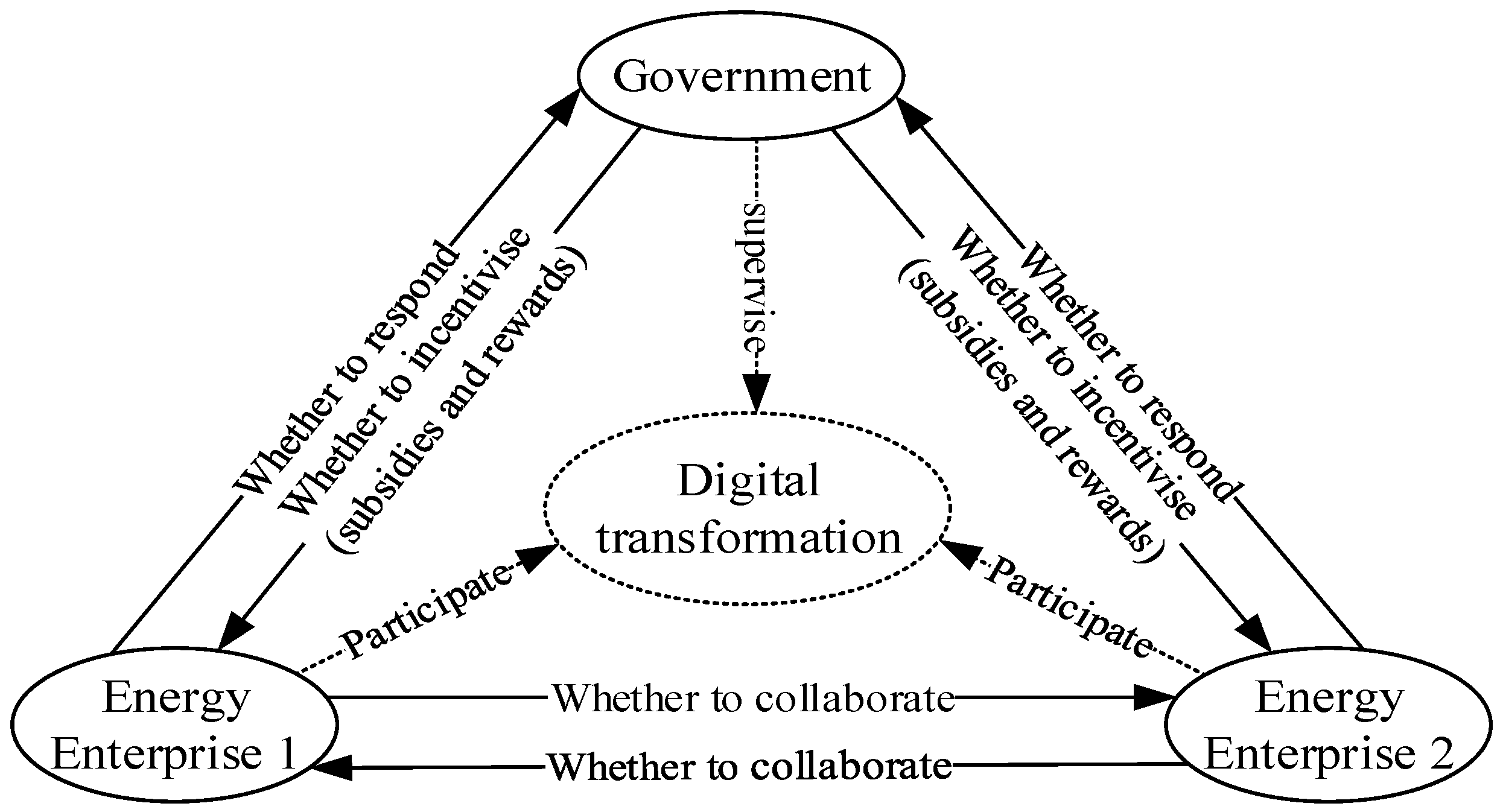
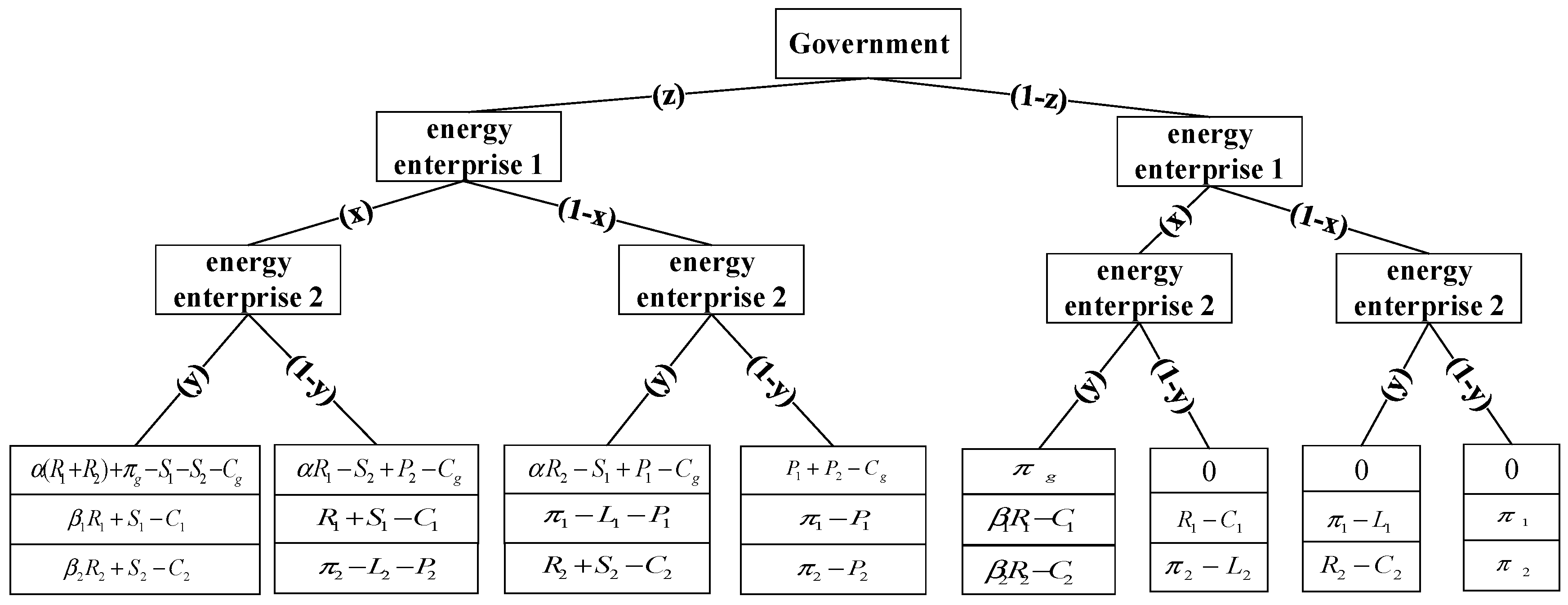





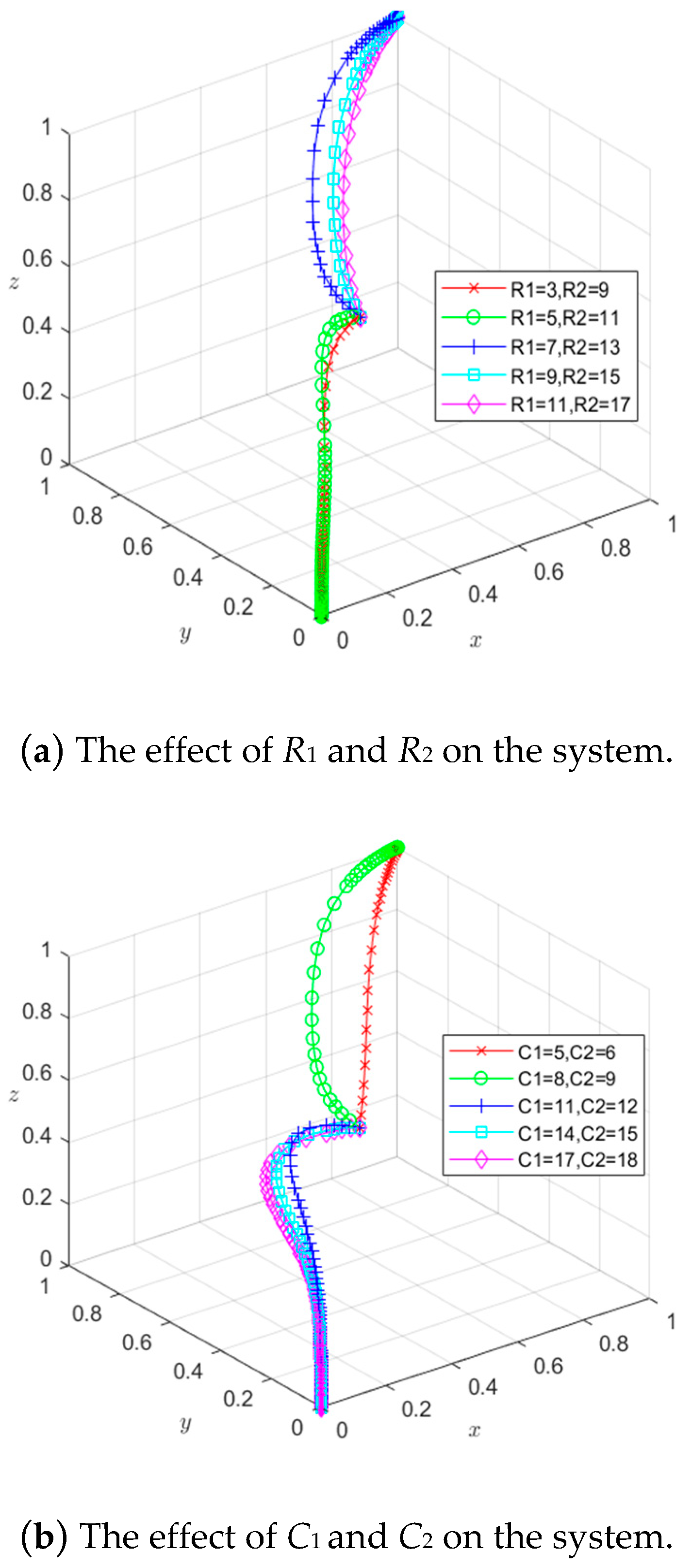
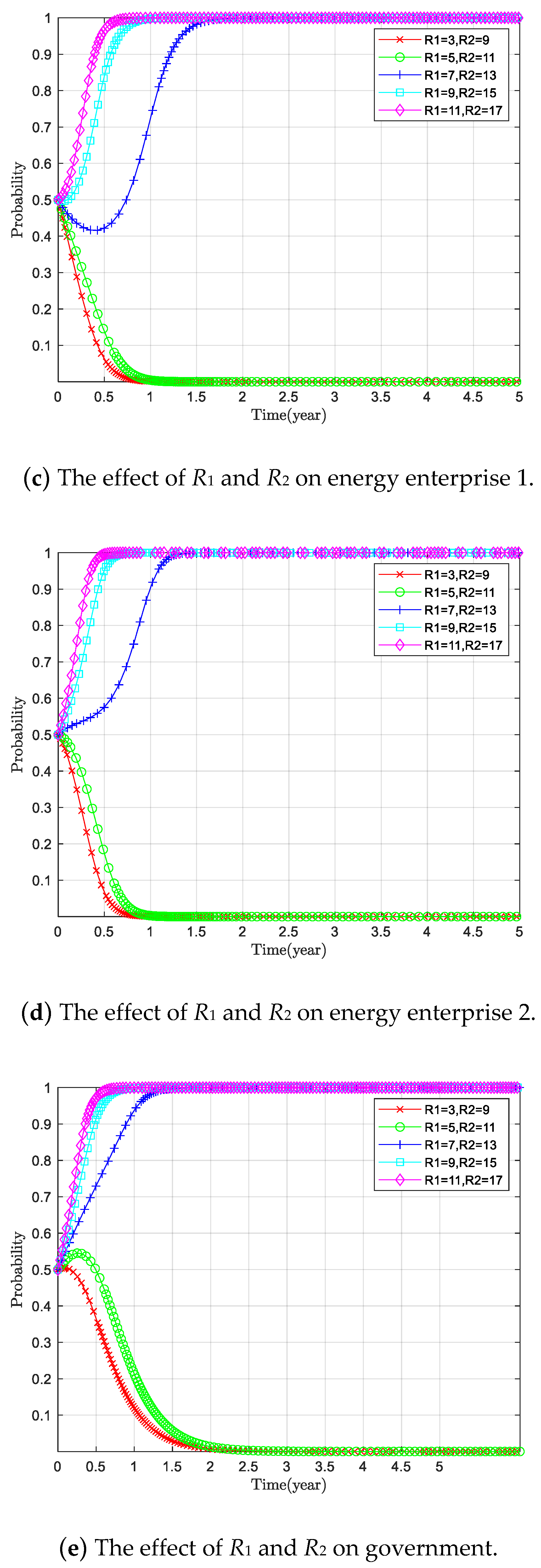
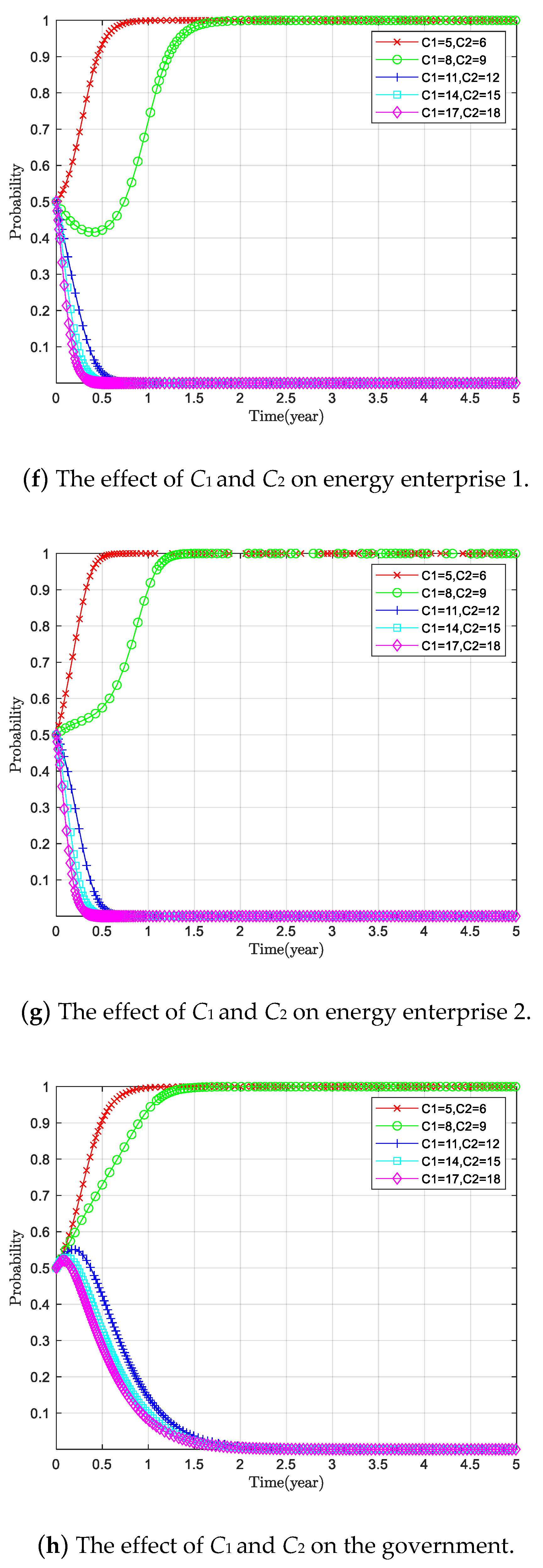
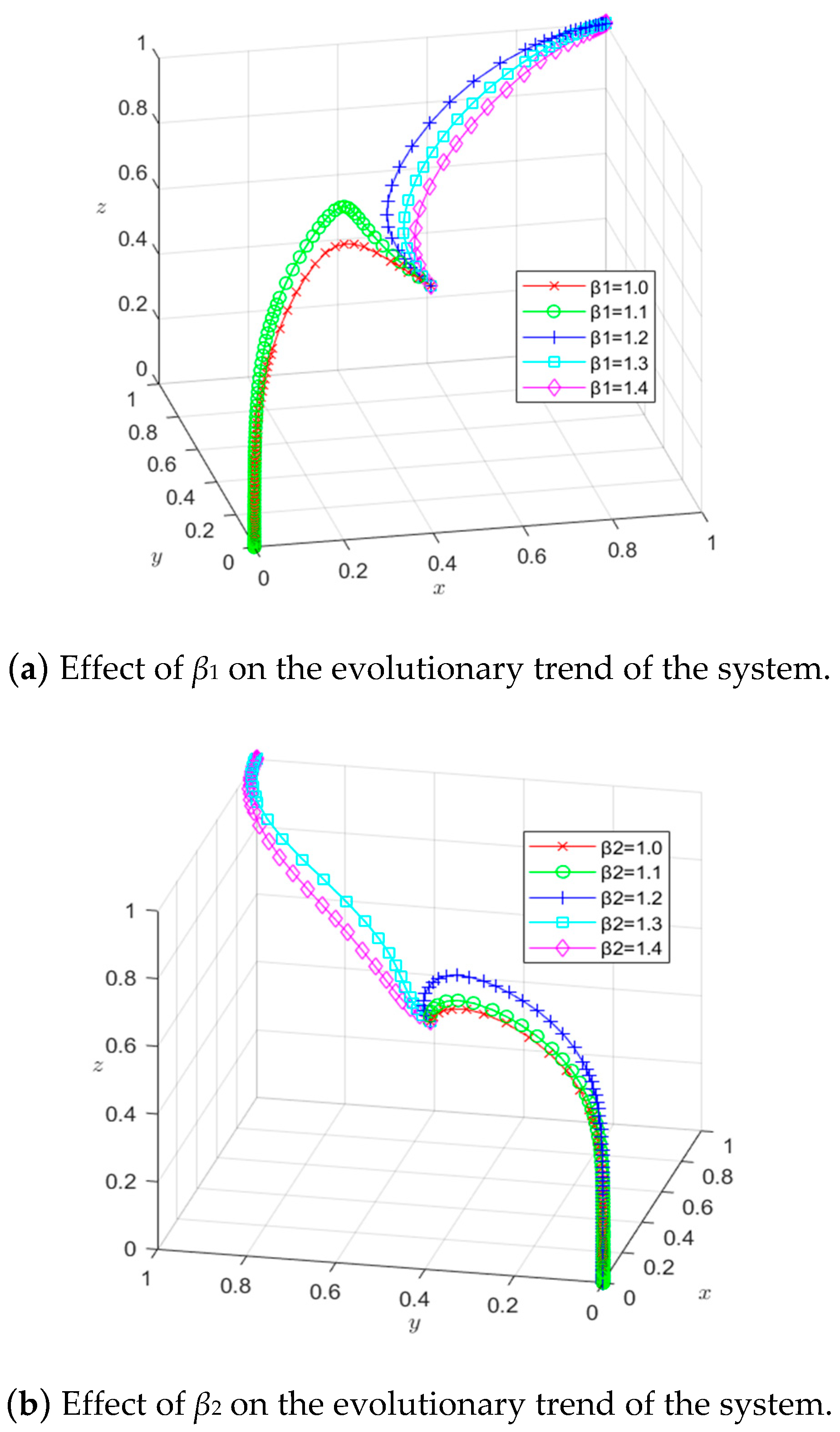

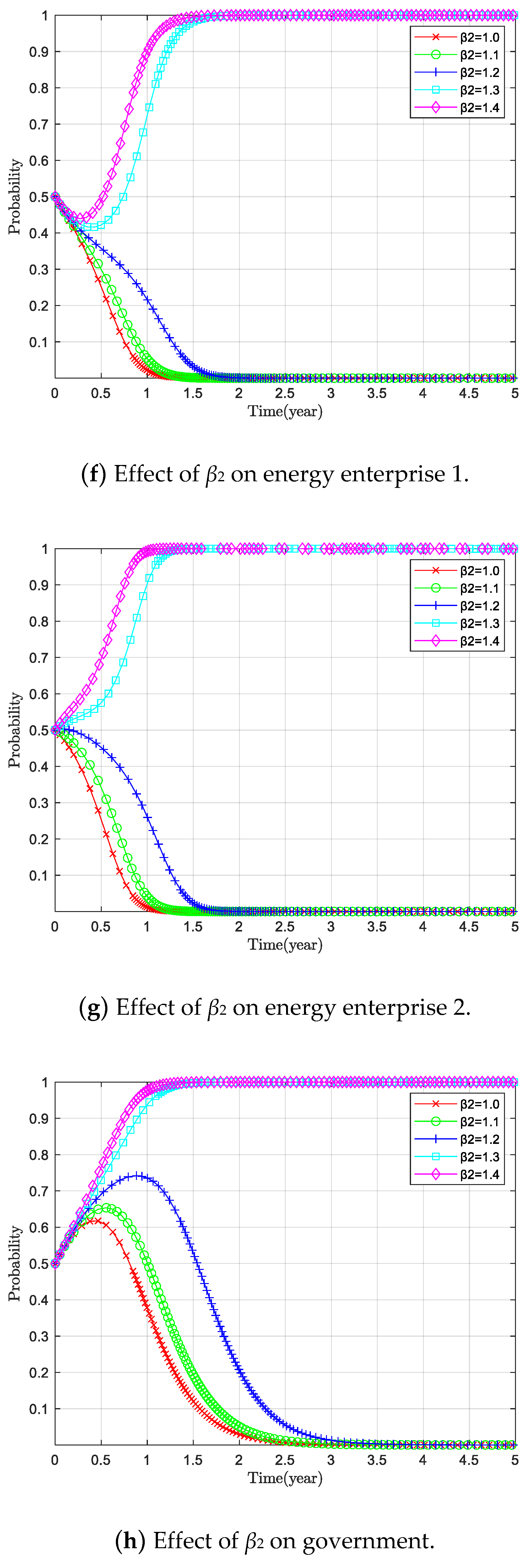

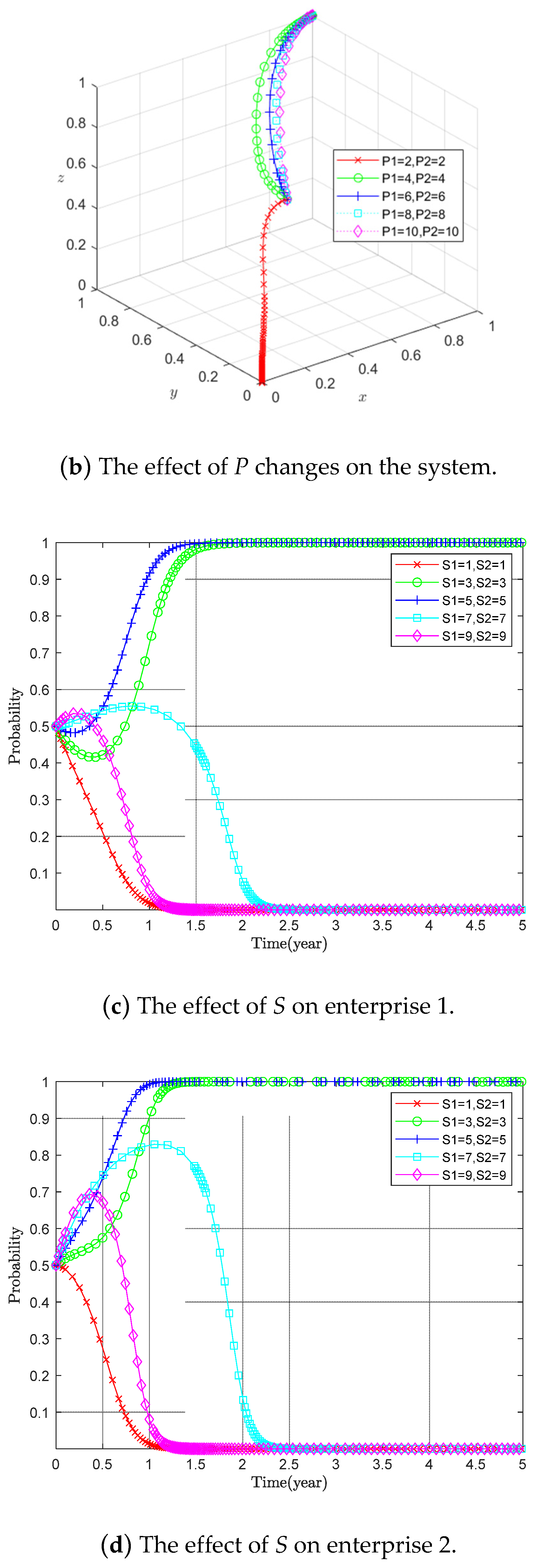
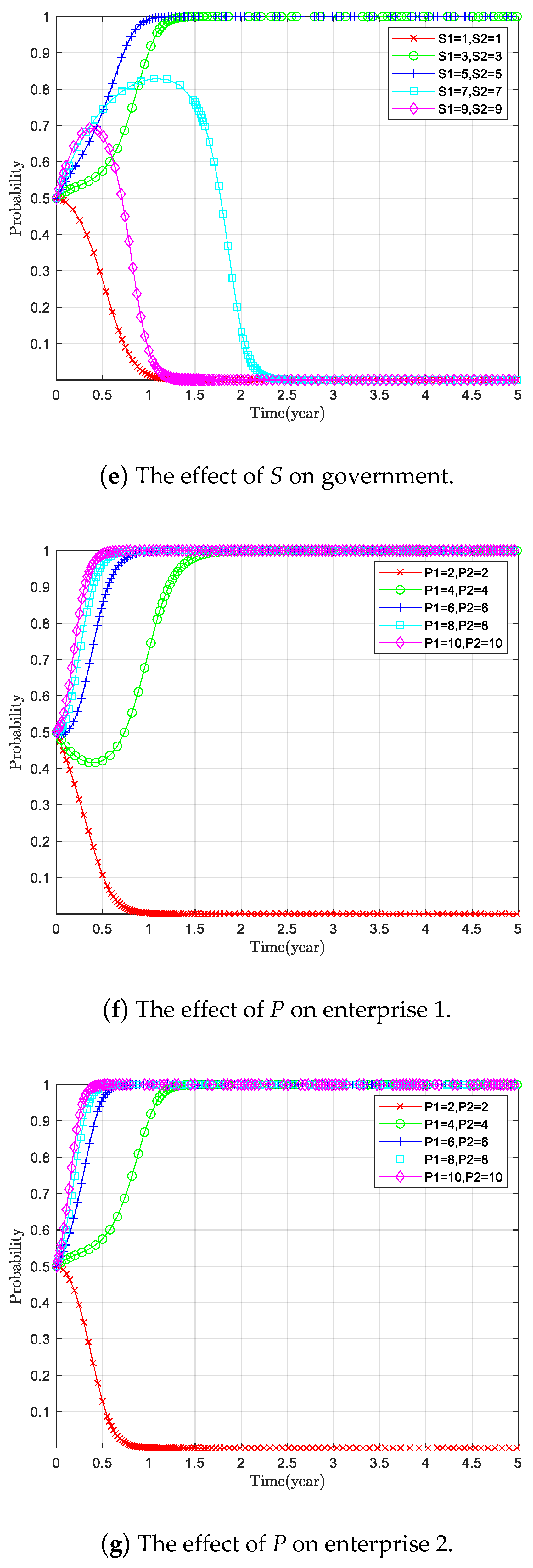

| Gaming Subjects | Parameters | Meaning of Expression |
|---|---|---|
| Energy Enterprise 1 | Probability that energy enterprise 1 is actively engaged in digital transformation | |
| Both energy enterprises 1 and 2 maintain the original technology and form of production and the benefits that energy enterprise 1 can obtain | ||
| Energy enterprise 2 undergoes a digital transformation, resulting in losses suffered by energy enterprise 1 in maintaining its original technology and form of production | ||
| Direct benefit gained by energy enterprise 1 after digital transformation | ||
| Coefficient of synergistic benefit to energy enterprise 1 from collaborative digital transformation of energy enterprises | ||
| The cost of digital transformation for energy enterprise 1 | ||
| Energy Enterprise 2 | Probability that energy enterprise 2 is actively engaged in digital transformation | |
| Both energy enterprise 1 and 2 maintain the original technology and form of production and the benefits that energy enterprise 2 can obtain | ||
| Energy enterprise 1 undergoes a digital transformation, resulting in losses suffered by energy enterprise 2 in maintaining its original technology and form of production | ||
| Direct benefit gained by energy enterprise 2 after digital transformation | ||
| Coefficient of synergistic benefit to energy enterprise 2 from collaborative digital transformation of energy enterprises | ||
| The cost of digital transformation for energy enterprise 2 | ||
| Government | Probability of government incentives for the digital transformation of energy enterprises | |
| Coefficient of public benefit from government incentives for the digital transformation of energy companies | ||
| The cost of implementing government incentives | ||
| Additional social benefits to the government from the collaborative digital transformation of energy enterprises 1 and 2 | ||
| Government incentives to subsidize digitally transformed energy enterprises | ||
| Government penalties for energy companies that fail to act on incentives |
| Government | Energy Enterprise 1 | Energy Enterprise 2 | |
|---|---|---|---|
| Transformation | No Transformation | ||
| Incentive | Transformation | ||
| No transformation | |||
| No incentive | Transformation | ||
| No transformation | 0 | ||
| Equilibrium Point | Stability | |||
|---|---|---|---|---|
| Case 1 | ||||
| Case 2 | ||||
| Instability point | ||||
| Case 3 | ||||
| Instability point | ||||
| Case 4 | ||||
| Case 5 | ||||
| Case 6 |
| Name | Stability Characterization |
|---|---|
| Case 1 | |
| Case 2 | |
| Case 3 | |
| Case 4 | |
| Case 5 | |
| Case 6 |
| 7 | 8 | 1.2 | 1.3 | 2 | 2 | 8 | 2 | 3 | 9 | 4 | 4 | 3 | 3 | 0.4 | 3 |
Disclaimer/Publisher’s Note: The statements, opinions and data contained in all publications are solely those of the individual author(s) and contributor(s) and not of MDPI and/or the editor(s). MDPI and/or the editor(s) disclaim responsibility for any injury to people or property resulting from any ideas, methods, instructions or products referred to in the content. |
© 2023 by the authors. Licensee MDPI, Basel, Switzerland. This article is an open access article distributed under the terms and conditions of the Creative Commons Attribution (CC BY) license (https://creativecommons.org/licenses/by/4.0/).
Share and Cite
Liu, P.; Wu, J. Game Analysis on Energy Enterprises’ Digital Transformation—Strategic Simulation for Guiding Role, Leading Role and Following Role. Sustainability 2023, 15, 9890. https://doi.org/10.3390/su15139890
Liu P, Wu J. Game Analysis on Energy Enterprises’ Digital Transformation—Strategic Simulation for Guiding Role, Leading Role and Following Role. Sustainability. 2023; 15(13):9890. https://doi.org/10.3390/su15139890
Chicago/Turabian StyleLiu, Pingkuo, and Jiahao Wu. 2023. "Game Analysis on Energy Enterprises’ Digital Transformation—Strategic Simulation for Guiding Role, Leading Role and Following Role" Sustainability 15, no. 13: 9890. https://doi.org/10.3390/su15139890
APA StyleLiu, P., & Wu, J. (2023). Game Analysis on Energy Enterprises’ Digital Transformation—Strategic Simulation for Guiding Role, Leading Role and Following Role. Sustainability, 15(13), 9890. https://doi.org/10.3390/su15139890





